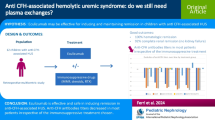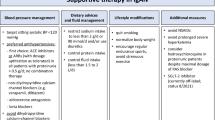Abstract
We compare the outcomes of induction therapies with either methylprednisolone (group 1, n = 58), basiliximab (group 2, n = 56) or alemtuzumab (group 3, n = 98) in primary deceased donor kidney transplants with delayed graft function (DGF). Protocol biopsies were performed. Maintenance was tacrolimus and mycophenolate with steroid (group 1 and 2) or without steroid (group 3). One-year biopsy-confirmed acute rejection (AR) rates were 27.6, 19.6 and 10.2 % in group 1, 2 and 3 (p = 0.007). AR was significantly lower in group 3 (p = 0.002) and group 2 (p = 0.03) than in group 1. One-year graft survival rates were 90, 96 and 100 % in group 1, 2 and 3 (log rank p = 0.006). Group 1 had inferior graft survival than group 2 (p = 0.03) and group 3 (p = 0.002). The patient survival rates were not different (96.6, 98.2 and 100 %, log rank p = 0.81). Multivariable analysis using methylprednisolone induction as control indicated that alemtuzumab (OR 0.31, 95 % CI 0.11–0.82; p = 0.03) and basiliximab (OR 0.60, 95 % CI 0.23–0.98; p = 0.018) were associated with lower risk of AR. Therefore, alemtuzumab or basiliximab induction decreases AR and improves graft survival than methylprednisolone alone in patients with DGF. Alemtuzumab induction might also allow patients with DGF to be maintained with contemporary steroid-withdrawal protocol.


Similar content being viewed by others
References
Siedlecki A, Irish W, Brennan D (2011) Delayed graft function in the kidney transplant. Am J Transplant 11(11):2279–2296
Sharif A, Richard B (2013) Delayed graft function after kidney transplanttion: the clinical perspective. Am J Kidney Dis 62(1):150–158
Mallon D, Summers D, Bradley A, Pettigrew G (2013) Defining delayed draft function after renal transplantation: simplest is best. Transplantation 96(10):885–889
Boom H, Mallat M, Fijter J et al (2000) Delayed graft function influences renal function, but not survival. Kidney Int 58:859–866
Nagaraja P, Roberts G, Stephens M et al (2012) Influence of delayed graft function and acute rejection on outcomes after kidney transplantation from donors after cardiac death. Transplantation 94(12):1218–1223
Tapiawala SN, Tinckam KJ, Cardella CJ et al (2010) Delayed graft function and the risk for death with a functioning graft. J Am Soc Nephrol 21:153–161
Qureshi F, Rabb H, Kasiske B (2002) Silent acute rejection during prolonged delayed graft function reduces kidney allograft survival. Transplantation 74(10):1400–1404
Yarlagadda SG, Coca SG, Formica RN Jr, Poggio ED, Parikh CR (2009) Association between delayed graft function and allograft and patient survival: a systematic review and meta-analysis. Nephrol Dial Transplant 24:1039–1047
Ojo AO, Wolfe RA, Held PJ, Port FK, Schmouder RL (1997) Delayed graft function: risk factors and implications for renal allograft survival. Transplantation 63:968–974
Troppmann C, Gillingham KJ, Gruessner RW et al (1996) Delayed graft function in the absence of rejection has no long-term impact. Transplantation 61:1331–1337
Boletis J, Balitsari A, Filiopoulos V et al (2005) Delayed renal graft function: the influence of immunosuppression. Transpl Proc 37:2054–2059
Ponticelli C (2014) Ischaemia-reperfusion injury: a major protagonist in kidney transplantation. Nephrol Dial Transplant 29(6):1134–1140
Goggins WC, Pascual MA, Powelson JA, Magee C, Tolkoff-Rubin N, Farrell ML, Ko DS, Williams WW, Chandraker A, Delmonico FL, Auchincloss H, Cosimi AB (2003) A prospective, randomized, clinical trial of intraoperative versus postoperative Thymoglobulin in adult cadaveric renal transplant recipients. Transplantation 76(5):798–802
Goncalves L, Ribeiro A, Berdichevski R et al (2007) Basiliximab improves graft survival in renal transplant recipients with delayed graft function. Transplant Proc 39(2):437–438
Chouhan K, Zhang R (2012) Antibody induction therapy in adult kidney transplantation, a controversy continues. World J Transplant 2(2):19–26
Brennan DC, Daller JA, Lake KD, Cibrik D, Del Castillo D (2006) Rabbit antithymocyte globulin versus basiliximab in renal transplantation. N Engl J Med 355:1967–1977
Webster AC, Ruster LP, McGee R, Matheson SL, Higgins GY, Willis NS, Chapman JR, Craig JC (2010) Interleukin 2 receptor antagonists for kidney transplant recipients. Cochrane Database Syst Rev (1):CD003897. doi:10.1002/14651858.CD003897.pub3
Noel C, Abramowicz D, Durand D et al (2009) Daclizumab versus antithymocyte globulin in high-immunological-risk renal transplant recipients. J Am Soc Nephrol 20:1385–1392
Andres A, Budde K, Clavien PA et al (2009) A randomized trial comparing renal function in older kidney transplant patients following delayed versus immediate tacrolimus administration. Transplantation 88:1101–1108
Kuypers DR, de Jonge H, Naesens M, Vanrenterghem Y (2010) A prospective, open-label, observational clinical cohort study of the association between delayed renal allograft function, tacrolimus exposure, and CYP3A5 genotype in adult recipients. Clin Ther 32:2012–2023
Novick AC, Hwei HH, Steinmuller D et al (1986) Detrimental effect of cyclosporine on initial function of cadaver renal allografts following extended preservation. Results of a randomized prospective study. Transplantation 42:154–158
Borobia AM, Romero I, Jimenez C et al (2009) Trough tacrolimus concentrations in the first week after kidney transplantation are related to acute rejection. Ther Drug Monit 31:436–442
Kumbala D, Zhang R (2013) The essential concept of transplant immunology for clinical practice. World J Transplant 3(4):113–118
Peeters P, Vanholder R (2008) Therapeutic interventions favorably influencing delayed and slow graft function in kidney transplantation: mission impossible? Transplantation 85:S31–S37
Arias M (2003) Impact of the delayed graft function in hypersensitized kidney transplant patients. Transplant Proc 35:1655–1657
Doshi MD, Garg N, Reese PP, Parikh CR (2011) Recipient risk factors associated with delayed graft function: a paired kidney analysis. Transplantation 91(6):666–671
Moers C, Smits J, Maathuis M et al (2009) Machine perfusion or cold storage in deceased-donor kidney transplantation. N Engl J Med 360:7–19
Matsuoka L, Shah T, Aswad S et al (2006) Pulsatile perfusion reduces the incidence of delayed graft function in expanded criteria donor kidney transplantation. Am J Transplant 6:1473–1478
McTaggart RA, Gottlieb D, Brooks J, Bacchetti P, Roberts JP, Tomlanovich S, Feng S (2003) Sirolimus prolongs recovery from delayed graft function after cadaveric renal transplantation. Am J Transplant 3:416–423
Gonwa T, Johnson C, Ahsan N et al (2003) Randomized trial of tacrolimus + mycophenolate mofetil or azathioprine versus cyclosporine + mycophenolate mofetil after cadaveric kidney transplantation: results at 3 years. Transplantation 75:2048–2053
Kidney Disease: Improving Global Outcomes (KDIGO) Transplant Work Group (2009) KDIGO clinical practice guideline for the care of kidney transplant recipients. Am J Transplant 9(Suppl 3):S1-155
van den Hoogen MWF, Kamburova EG, Baas MC, Steenbergen EJ, Florquin SM, Koenen HJP, Joosten I, Hilbrands LB (2015) Rituximab as induction therapy after renal transplantation: a randomized, double-blind, placebo-controlled study of efficacy and safety. Am J Transplant 2015(15):407–416
Kaufman DB, Leventhal JR, Axelrod D, Gallon LG, Parker MA, Stuart FP (2005) Alemtuzumab induction and prednisone-free maintenance immunotherapy in kidney transplantation: comparison with basiliximab induction–long-term results. Am J Transplant 5(10):2539–2548
Hanaway MJ, Woodle ES, Mulgaonkar S et al (2011) Alemtuzumab induction in renal transplantation. N Engl J Med 364(20):1909–1919
Haynes R, Harden P, Judge P et al (2014) Alemtuzumab-based induction treatment versus basiliximab-based induction treatment in kidney transplantation (the 3C Study): a randomised trial. Lancet 384(9955):1684–1690
Silva DM, Garcia JP, Ribeiro AR et al (2007) Utility of biopsy in kidney transplants with delayed graft function and acute dysfunction. Transplant Proc 39(2):376–377
Georg A, Heinz R, Walter H (2005) Protocol biopsies after kidney transplantation. Transpl Int 18:131
Acknowledgments
We thank the members of Tulane Transplant Institute for maintaining the transplant data base.
Author information
Authors and Affiliations
Corresponding author
Ethics declarations
Conflict of interest
The authors declare that they have no conflict of interest.
Human rights statement
This study was approved by the Institutional Review Board (IRB) of Tulane University.
Informed consent
Informed consent from individual participant is not indicated as it is a retrospective analysis and there is no identifying information about any participant in the article.
Rights and permissions
About this article
Cite this article
Umber, A., Killackey, M., Paramesh, A. et al. A comparison of three induction therapies on patients with delayed graft function after kidney transplantation. J Nephrol 30, 289–295 (2017). https://doi.org/10.1007/s40620-016-0304-7
Received:
Accepted:
Published:
Issue Date:
DOI: https://doi.org/10.1007/s40620-016-0304-7




